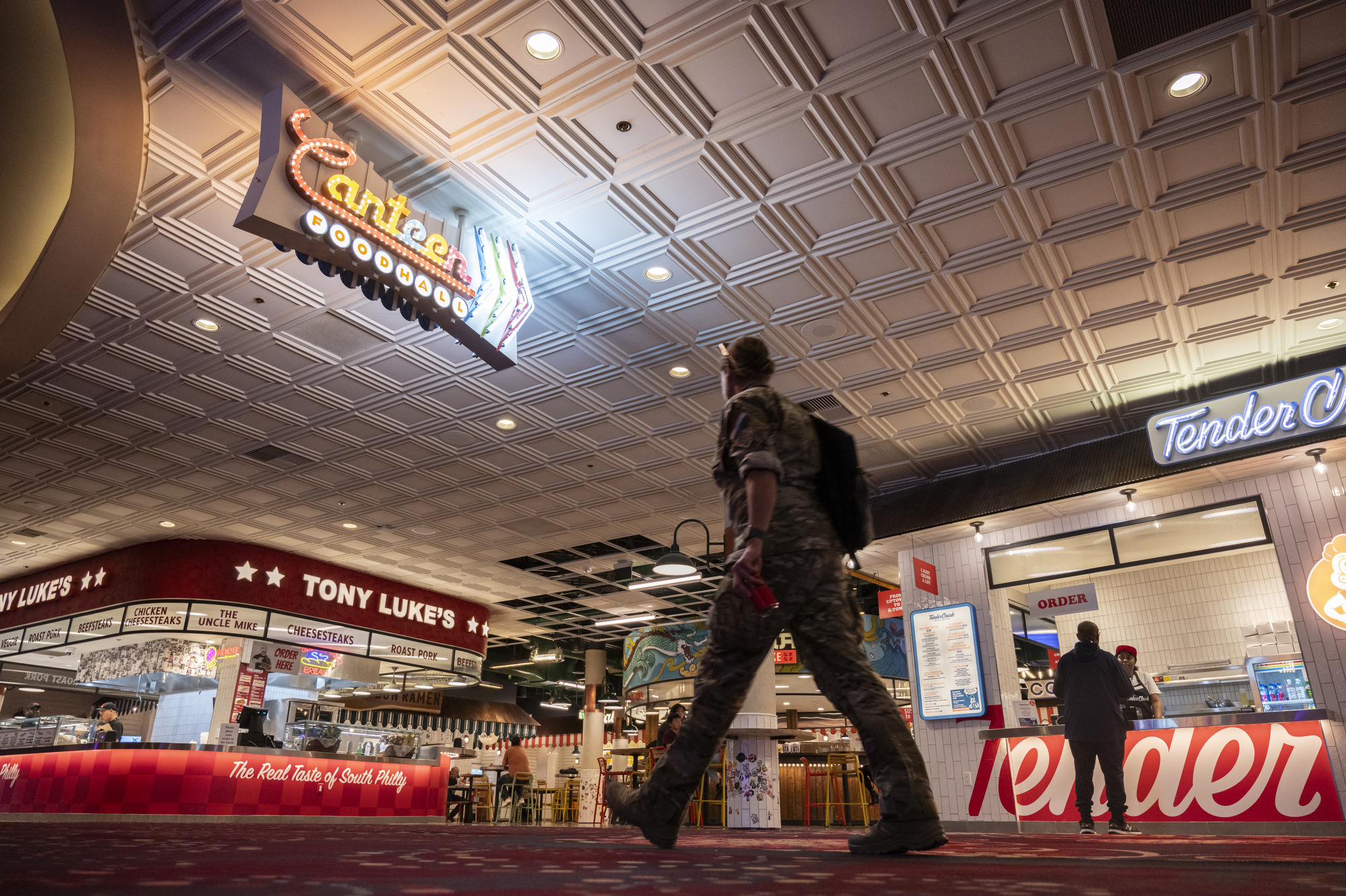Food halls replacing buffets as casinos look to improve their bottom line

“What happened with the Carnival World Buffet?” Gaming Control Board member George Assad asked Dreamscape executives at a gaming license hearing last summer to allow the company to assume operations of the Rio Hotel & Casino.
“Why isn’t it coming back? There were always lines out into the casino floor.”
Patrick Hoefler, who took over as vice president of food and beverage at the Rio following Dreamscape’s licensing, said the Carnival World Buffet’s popularity didn’t translate into profitability — a common occurrence with most Las Vegas buffets.
“In the best case scenario, buffets made a little bit of money,” Hoefler said recently. “Most often, buffets either broke even or lost money. As time went on, guests were looking for something different.”
Dreamscape officials told gaming regulators Rio’s buffet would be replaced by a food hall, a growing concept similar to a food court where established or new restaurants operate a small branded location in a shared setting without the overhead costs associated with a standalone business.
For Dreamscape and other casino operators, food halls have become a more financially sound alternative to buffets, which traditionally offered all-you-can-eat items at low prices. It’s a shift similar to how food trucks gave customers a way to move from large chain restaurants to something unique but fast and affordable, and food halls are expected to grow to a nearly $72 billion industry by 2026, according to TouchBistro, a restaurant industry technology provider.
The off-Strip Rio opened Canteen Food Hall in January, taking up a small portion of the former Carnival World space with six outlets that resonate with Las Vegas residents and tourists based on the restaurant specialties, brand names and familiar operators.
Dreamscape signed licensing agreements to bring South Philadelphia cheesesteak operator Tony Luke’s to Las Vegas in a prominent spot in Rio’s food hall. Chris Barish and Julie Mulligan, who created Black Tap Craft Burgers & Beer at The Venetian, were lured to the off-Strip Rio to open their chicken-themed eatery Tender Crush.
“We wanted to do something a little more unique,” Hoefler said.
Tony Luke’s, is well known in Philadelphia and beyond and already operates a space inside the Borgata Resort and Casino in Atlantic City. The other operators are well known to Las Vegas locals.
The food hall also includes Nama Nama, a Japanese street food-style sushi eatery that was developed by the same team that created Tekka Bar at the Cosmopolitan of Las Vegas.
One of its creators, Oliver Wharton, said the vibrancy of the food hall fits the market Nama Nama is trying to reach, given its menu of sushi and poke bowls.
“For the Rio, the food hall is kind of our first great step to energize the building,” Wharton said.
Food halls have launched in casinos throughout Las Vegas in the past year, including on the Strip (Aria Resort & Casino, Fontainebleau Las Vegas), downtown (Fremont Hotel and Casino), off-Strip (Rio) and the locals market (Durango Casino Resort).
Meanwhile, just 14 buffets were operating in Las Vegas casinos at the end of February, according to Las Vegas Advisor, down from 18 in the publication’s last survey a few months ago. The declining figure didn’t surprise gaming historian and author David G. Schwartz.
When buffets were introduced in the early years of Las Vegas, Schwartz said the all-you-can-eat concept was “the perfect casino restaurant since it could deliver an abundance of food to guests quickly, getting them back out to the casino so that they could gamble more.”
But now, non-gaming revenue such as dining eclipses casino revenue by upwards of 64 percent to 35 percent. Strip resorts have become a haven for Michelin-starred restaurants and high-priced dining attractions headed by celebrity chefs. Las Vegas is viewed as a travel destination for “foodies,” whose primary reason for visiting a Strip resort is the dining aspect. Restaurant tabs have been known to hit six figures for a large party.
“Now that more visitors do not gamble and food and beverage is not considered a loss leader, it's not surprising to see a switch from dining as a necessity to dining as an experience,” Schwartz said.


A financial decision
Buffets — 99 cents per person in many places dating back to the 1960s through the early 1980s — were once viewed as an essential dining option at any Las Vegas casino.
But similar to coin-operated slot machines or $1 blackjack, buffets were rarely profitable because of the cost of purchasing the product versus the traditionally lower price paid by customers. The Strip’s two largest casino operators — Caesars Entertainment and MGM Resorts International — have either eliminated or reduced the number of buffet offerings.
Macquarie Securities gaming analyst Chad Beynon said in an interview the decision to move away from buffets was purely driven by the bottom line.
“If you have more properties, you can analyze the numbers and look at how unprofitable these buffets are,” Beynon said.
He suggested it’s more cost-effective for casinos to rent out the buffet space to either food court-type restaurants or to another business the casino is operating or leasing.
The pandemic, which led to a shutdown of the state’s casino industry for 78 days in 2020, became the impetus for eliminating buffets. As resorts reopened with various health and safety restrictions that stretched into 2021, buffets were kept shuttered given the onerous challenges, such as removing the serve-yourself aspect out of concerns that shared serving utensils would transfer COVID.
During that time, gaming leaders said there would be a change in direction while re-evaluating business models.
"We’re going to put the dollars into the place where we make money,” Red Rock CEO Frank Fertitta III said in October 2020 when the company announced it was pulling buffets from its casinos.
Red Rock converted the buffet space at its flagship Red Rock Resort and Green Valley Ranch properties into multiple sit-down restaurants and casino bars. Boulder Station’s buffet area was turned into a traditional food court with recognized outlets. The company is determining what will fill the walled-off buffet spaces at its other three Las Vegas properties.
The two most recent casino openings — the $780 million Durango and the $3.7 billion Fontainebleau — skipped buffets in favor of large food hall settings.
Boyd Gaming has closed all its buffets except for the Garden Court at Main Street Station as part of an effort, triggered by COVID, to reinvest in a higher-end customer. Last year, the company converted the buffet area at Fremont into a 13,000-square-foot food hall with six national and local restaurant brands. The move was part of an overall remodeling of the downtown casino.
“We buy into that concept that you're actually able to provide a more modern experience and a better experience for the customer by giving them a broader variety in a different setting,” said Boyd Gaming CEO Keith Smith.
Back in 2021, Caesars Entertainment CEO Tom Reeg lamented the high costs of maintaining buffets. He said it didn’t make sense to retain buffets in Las Vegas and Caesars’ regional casino markets.
“We're going to be smarter about where we are in the food and beverage business,” Reeg said. “We're not bleeding $3 million in every buffet in the country. We're going to figure out how to do it in a way that meets customer demand and maximizes our profitability.”


New ideas
In 2018, MGM Resorts brought Eataly, an Italian mega-market concept, to a 40,000-square-foot space at a Strip-facing entrance at Park MGM. The location is one of nine Eatalys in the U.S. where customers can sample and learn about authentic Italian dishes in both casual and fine dining restaurants but also shop for Italian products.
“Eataly can be considered one of the first food halls to hit the market,” said Megan Humphreys, MGM Resorts’ vice president of food and beverage strategy.
The opening of the $4.3 billion Resorts World Las Vegas in June 2021 came with 20 fine dining and casual eateries, but absent a buffet. However, operators created Famous Foods, which was inspired by the street market food scene of Southeast Asia, with 19 individual food stands.
MGM went the food hall route in December 2022 at Aria, opening Proper Eats, a nine-outlet location that replaced CityCenter’s buffet.
“After the pandemic, we saw an opportunity to create a new experience,” Humphreys said.
Canteen Food Hall allowed Rio to try out new technology, such as an ordering menu kiosk where customers can order items from multiple outlets, pay with a credit card and be notified by a text message when the food arrives.
“It’s about convenience for the customer,” Hoefler said.


Buffets are not completely dead
Caesars still operates the Bacchanal Buffet at Caesars Palace, which carries a charge of between $40 and $50 per person depending on the day. The buffet covers 25,000 square feet and has 10 kitchens, nine chef-attended stations and more than 250 menu items. MGM Resorts still maintains buffet operations at Bellagio, MGM Grand, Luxor and Excalibur.
The Palms Casino Resort kept its A.C.Y.E. Buffet when the casino reopened in April 2022 after the business division of Southern California’s San Manuel Indian Tribe acquired the property from Red Rock Resorts a year earlier.
Marcus O'Brien, the Palms’ executive chef and senior executive director of food and beverage, said a Friday night menu of prime rib and snow crab as well as a brunch buffet daily resonates with customers.
Palms also has a Wednesday night lobster buffet, which, at $65 per person, is more expensive than Caesars’ Bacchanal Buffet.
“We looked at the opportunity to be different,” O’Brien said. “We hear from customers who enjoy that dining option.”
The South Point Hotel & Casino, which is owned and operated by Las Vegas gaming icon Michael Gaughan, is viewed as “old school” when it comes to dining and has never considered dropping the buffet.
“Despite this trend, our buffet is not going anywhere,” South Point General Manager Ryan Growney said in an email. “Our decision was based on the belief that it is essential to give people what they want and our customers enjoy the buffet.”
Food halls have yet to catch on at Northern Nevada casinos, although Legends Bay Casino in Sparks opened in August 2022 with three food trucks inside the property offering three menu options — barbecue, Mexican and Italian.
The trucks have custom-made facades but are actual working food trucks that have been modified and converted. The tires remained, but the transmissions and engines were removed. Doorways behind the trucks connect to the back-of-the-house kitchen.
In Reno, Caesars eliminated the buffets at its three Reno properties that make up The Row — Eldorado, Silver Legacy and Circus Circus. However, Grand Sierra and Atlantis offer traditional casino buffets.
John Farahi, chairman and CEO of Atlantis parent Monarch Resorts, said closing the buffet was never an option.
“The locals have always rated us the best buffet in Northern Nevada because of the quality of our food,” Farahi said. “The days of cheap buffets are gone and we decided we will always have a buffet because that is what our customers want.”
